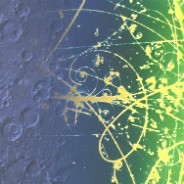Составьте пересказ текста(5-7 предложений) The Lab between the Stars
In space, where a hydrogen atom might fly for a million years before finding a soul mate, the opportunities for significant chemistry might appear a little on the limited side. Nothing could be further from the truth. The Universe is a big place and one thing which is not in short supply is time. Most chemistry, despite the impression that is given to students by university courses, occurs not on Earth but in the yawning chasm between the stars. There is mode alcohol, for instance, in the average molecular gas cloud than has ever been distilled in the entire history of the human race.
Granted, "astrochemistry" may not be quite as complex as Earthbound chemistry, whether in the laboratory, industry or living organisms. Nevertheless, it is far more intricate than anyone would have guessed even a few decades ago. It embraces esoteric processes, the likes of which are never seen in the high-density environment on Earth. Furthermore, astrochemistry actually orchestrates a great deal of what goes on in the Universe, which is precisely what is detailed in The Chemically Controlled Cosmosby Thomas Hartquist of the Max Planck Institute for Extraterrestrial Physic in Munich and David Williams of University College London.
Molecules form, the authors tell us, whenever the temperature of matter falls below 3000°C. And since most of the Universe is either colder than this, or has been colder than this at least once since the big bang, molecules have been a ubiquitous feature of the cosmos throughout most of its history. The first time the temperature dipped beneath 3000°C, say Hartquist and Williams, was in the rapidly expanding fireball of the big bang about a million years after the moment of creation. Chemistry in this remote epoch was rudimentary because very few elements heavier than hydrogen and helium were forged in the fiery furnace of the big bang. Nevertheless, molecular hydrogen played a crucial role in cooling the cores of giant gas clouds so that they could shrink under their own gravity.
Without its ability to radiate away heat generated during the process, say Hartquist and Williams, pressure from the hot gas would have prevented galaxies like our own Milky Way from congealing from the stuff of the big bang. Molecules have the ability to remove heat from a gas because when they collide with each other some of their energy of motion is inevitably converted into internal energy. This energy can later be shed in the form of photons.
A molecule can be thought of as a collection of balls connected by springs. The whole structure can vibrate and rotate and, when it is buffeted by other molecules, can be made to vibrate or rotate even faster. Because the laws of quantum mechanics permit only certain rates of vibration and rotation, when the molecule sheds energy by emitting photons it does so at only certain characteristic wavelengths, usually in the infrared of millimetre wave region of the spectrum. For instance, carbon monoxide, the most abundant molecule in space after molecular hydrogen, emits a characteristic spectral "line" at a wavelength of 2-6 millimetres.
169
216
Ответы на вопрос:
Популярно: Английский язык
-
Закончите разделительные вопросы,обращая внимание на форму глагола в основной...
 olya0207200004.09.2021 06:05
olya0207200004.09.2021 06:05 -
1) are they friends? -yes,) are bob and tom friends? -no,)is she nice? -yes,)is...
 антон77627.09.2021 04:05
антон77627.09.2021 04:05 -
Then read and learm it by heart.act it out...
 королева572026.08.2022 19:44
королева572026.08.2022 19:44 -
Надо писать что я пью днём, абаде, ужне...
 demon95940223.04.2020 17:17
demon95940223.04.2020 17:17 -
Сообщение об изумрудном будде (на ) 50б...
 UnknownKnowns08.09.2020 21:02
UnknownKnowns08.09.2020 21:02 -
Put the words in exercise 1 into the correct column.can you add some more words?...
 настёнканяш13.06.2021 12:01
настёнканяш13.06.2021 12:01 -
1.when he came home reat) an interesting story about animals. 2.kate entered...
 soykaksyu21.06.2023 16:09
soykaksyu21.06.2023 16:09 -
Доклад по обж безопасность на водоёмах в зимнее время...
 anastasiatim4e230.05.2023 11:39
anastasiatim4e230.05.2023 11:39 -
Look at the pictures. Make sentences about tikets using cardinal numerals. Loking...
 hhggg128.11.2022 12:39
hhggg128.11.2022 12:39 -
Some people call it a sea, while others call it a lake. In ancient times, people...
 alena0bashinskaya15.10.2020 22:43
alena0bashinskaya15.10.2020 22:43
